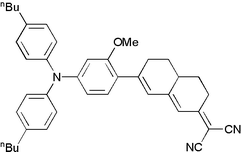Synthesis and stability studies of conformationally locked 4-(diarylamino)aryl- and 4-(dialkylamino)phenyl-substituted second-order nonlinear optical polyenechromophores
Abstract
A series of

* Corresponding authors
a Beckman Institute, California Institute of Technology, Pasadena, CA 91125, USA
b
Department of Chemistry, University of Arizona Tucson, AZ 85721, USA
E-mail:
sbarlow@email.arizona.edu
c Gemfire Research, 2440 Embarcadero Way, Palo Alto, CA 94303, USA
d Institut de Physique et Chimie Matériaux de Strasbourg, Groupe d'Optique nonlinéaire et d'Optoélectronique (UM 046 CNRS), rue du Loess 23, Strasbourg Cedex, France
e Optical Sciences Center, University of Arizona Tucson, AZ 85721, USA
A series of

 Please wait while we load your content...
Something went wrong. Try again?
Please wait while we load your content...
Something went wrong. Try again?
K. Staub, G. A. Levina, S. Barlow, T. C. Kowalczyk, H. S. Lackritz, M. Barzoukas, A. Fort and S. R. Marder, J. Mater. Chem., 2003, 13, 825 DOI: 10.1039/B208024A
To request permission to reproduce material from this article, please go to the Copyright Clearance Center request page.
If you are an author contributing to an RSC publication, you do not need to request permission provided correct acknowledgement is given.
If you are the author of this article, you do not need to request permission to reproduce figures and diagrams provided correct acknowledgement is given. If you want to reproduce the whole article in a third-party publication (excluding your thesis/dissertation for which permission is not required) please go to the Copyright Clearance Center request page.
Read more about how to correctly acknowledge RSC content.
 Fetching data from CrossRef.
Fetching data from CrossRef.
This may take some time to load.
Loading related content
